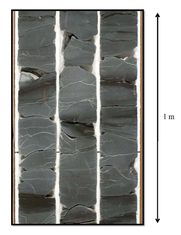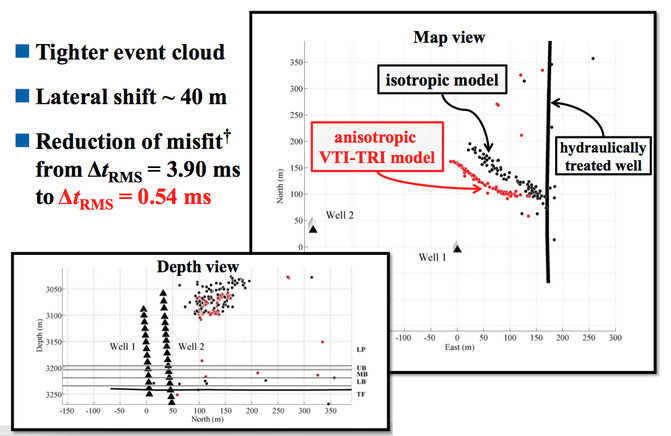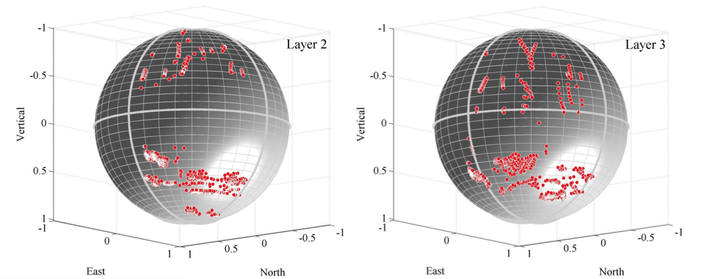At Borehole Seismic LLC, borehole, surface, and shallow-buried-array microseismic is our specialty. We deliver accurate and unbiased results superior to those of larger service companies.
Why We Offer A Better Solution
The current industry standard for processing microseismic data builds velocity models with log data (sonic log, density log, and perhaps cross-dipole sonic log for anisotropic media), and then calibrates those models with perforation shot data. The models are then used to process all data to locate microseismic events throughout the course of a hydraulic fracture treatment.
This standard method suffers from several problems:
This standard method suffers from several problems:
|
Problem - Unconventional shale gas reservoirs are anisotropic due to the nature of shale and pre-existing fractures. Resources to estimate anisotropic parameters like dipole sonic logs or core samples are limited, and the industry-standard method often models an inferior isotropic medium which is unlike the actual reservoir.
Solution - Instead of using only perforation shots (which provide limited aperture) to calibrate a velocity model, Borehole Seismic incorporates all available data (both perfshots and events). Depending upon survey geometry and ray coverage, all elastic parameters in a dipping layered arbitrary anisotropic medium can be estimated (21 elastic constants for each layer).
|
Problem - Industry-standard methods use constant velocity models calibrated before frac start to process all data, resulting in large uncertainties for calculated event locations. The misfit between calculated and observed travel times is often one to two milliseconds (big). A competent velocity model should gradually change as hydraulic fractures grow.
Solution - Borehole Seismic Reprocessing™ Services use velocity models calculated dynamically throughout the course of a frac job. Dynamically calculated velocity models more closely resemble the actual conditions of a reservoir because more data constrains the model. This method dramatically reduces misfits between calculated and observed travel times, and we therefore have markedly higher confidence in event locations.
Problem - Assumptions lead to uncertainty. Industry-standard methods assume overly-simplified reservoir characteristics, and even double-difference tomography (a recent improvement over the industry standard) assumes that microseismic events are clustered and that their raypaths are close to each other. Such assumptions may produce incorrect clustered event trends and other calculation artifacts.
Solution - Borehole Seismic Reprocessing™ Services use fewer assumptions, so our solution suffers from fewer artifacts or biased-trend issues. The inversion method we use is flexible such that, depending upon calculated ray coverage, we can reduce or add complexity to the velocity model to ensure that inversion is both stable and accurate. Additional information like core samples or dipole-sonic logs are not required, but can be incorporated to further constrain inversion, and single-array recordings can also use polarization derived from hodogram analysis to help constrain results. We model our inversion to a particular job like existing relative location methods (for example, double-difference tomography), but without clustering the events or other biased results induced by those methods.
Would you like to know more? See how we do it.
¹ Grechka, V. and Yaskevich, S. (2014), Azimuthal anisotropy in microseismic monitoring: A Bakken case study. 79 Geophysics 1, 11-15. doi: 10.1190/geo2013-0211.1
² Grechka, V. and Yaskevich, S. (2013), Inversion of microseismic data for triclinic velocity models. Geophysical Prospecting 61: 1159–1170. doi: 10.1111/1365-2478.12042
³ Grechka, V. and Yaskevich, S. (2014), Anisotropic Velocity Model Building in Microseismic Monitoring. GSH Journal 4.5, 11-15.
² Grechka, V. and Yaskevich, S. (2013), Inversion of microseismic data for triclinic velocity models. Geophysical Prospecting 61: 1159–1170. doi: 10.1111/1365-2478.12042
³ Grechka, V. and Yaskevich, S. (2014), Anisotropic Velocity Model Building in Microseismic Monitoring. GSH Journal 4.5, 11-15.




